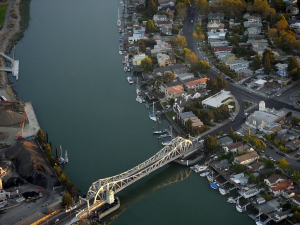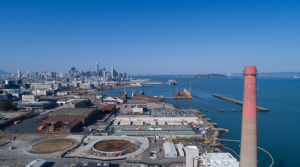The ART Program has assessed private sector businesses and industry in project areas around the Bay. These findings are likely relevant even in places that have not been assessed, especially areas in San Francisco and the South Bay where extensive business development in low lying regions near the shore occur. Commercial and industrial businesses around the Bay are valuable in providing jobs, helping drive local, national and international economies, and supporting the research, development and production of critical goods. The temporary closure or permanent loss of these businesses would have widespread consequences in the Bay and around the world.
Key Findings
Commercial Businesses
Commercial businesses are an important part of the functioning of local communities as residents tend to shop and access critical services, such as medical care or community services, close to where they live and work. Additionally, community members with limited mobility and/or those that rely on public transit typically have few options for travelling outside of their neighborhood to access jobs, necessary services and critical goods.
Access to commercial facilities may be disrupted due to a flood event, which can have far-reaching consequences on local communities. These impacts include workers being unable to report to work, and necessary goods and services becoming unavailable to community members. Most commercial buildings today are not designed to withstand flooding, and even those not directly at risk from flooding exposure are vulnerable if roads providing access are flooded, or if power, water or wastewater services are disrupted. Even temporary closure of commercial uses can have significant social and economic impacts on neighborhoods and communities and can impede recovery after a flood event.
Furthermore, because commercial land uses are privately owned, there is often a lack of publicly available information about the vulnerabilities of these facilities and operations, as well as the economic, environmental and social consequences resulting from flooding impacts. For example, small businesses may be operated by landowners that do not have the capacity to engage in local planning, or by renters that have little control over improvements to the property where their business is located.
Industrial
Industrial sites face a variety of vulnerabilities to sea level rise, both directly to their facilities as well as offsite issues that can impact their operations. Because heavy industrial land uses need large amounts of land, have specific operational facility needs, and are dependent on fixed infrastructure for goods movement (e.g., marine terminals, pipelines and rail lines), these land uses can be difficult, if not impossible, to relocate. This infrastructure and associated facilities that have at- or below-grade entrances or sensitive equipment will be especially vulnerable if exposed to salt water. Many industrial land uses rely on off-site utilities connections (e.g., power, telecommunications, water supply, and wastewater treatment or discharge), and to roads, rail lines, pipelines and airports that may be vulnerable to sea level rise impacts. Finally, many industrial land uses generate or store hazardous substances that could have public health or environmental impacts if released into groundwater or surface waters.
Some large industrial property owners and site operators who understand their risk from coastal hazards, such as sea level rise, sometimes engage with public agencies on reducing risks through existing programs. However, due to the potential complexities of land ownership, management, municipal jurisdictions, and the regulatory landscape, planning for sea level rise will require additional, collaboration and partnerships between the public and private sector to promote multi-benefit shoreline solutions that balance economic, environmental and social equity goals.
Findings and Materials
- Alameda County ART Project Community Land Use Profile Sheet
- Profile Sheet: Community Land Use
- Existing Conditions and Stressors: Community Land Use
- Alameda County Vulnerability and Risk: Community Land Use
- ART Alameda County Adaptation Responses for Community Land Use
- Contra Costa ART Project Business and Industry Chapter
Findings and Materials
- Alameda County ART Project Community Land Use Profile Sheet
- Profile Sheet: Community Land Use
- Existing Conditions and Stressors: Community Land Use
- Alameda County Vulnerability and Risk: Community Land Use
- ART Alameda County Adaptation Responses for Community Land Use
- Contra Costa ART Project Business and Industry Chapter

For more information:
- Jaclyn Mandoske
- Jaclyn.Mandoske@bcdc.ca.gov
- 415-352-3631

